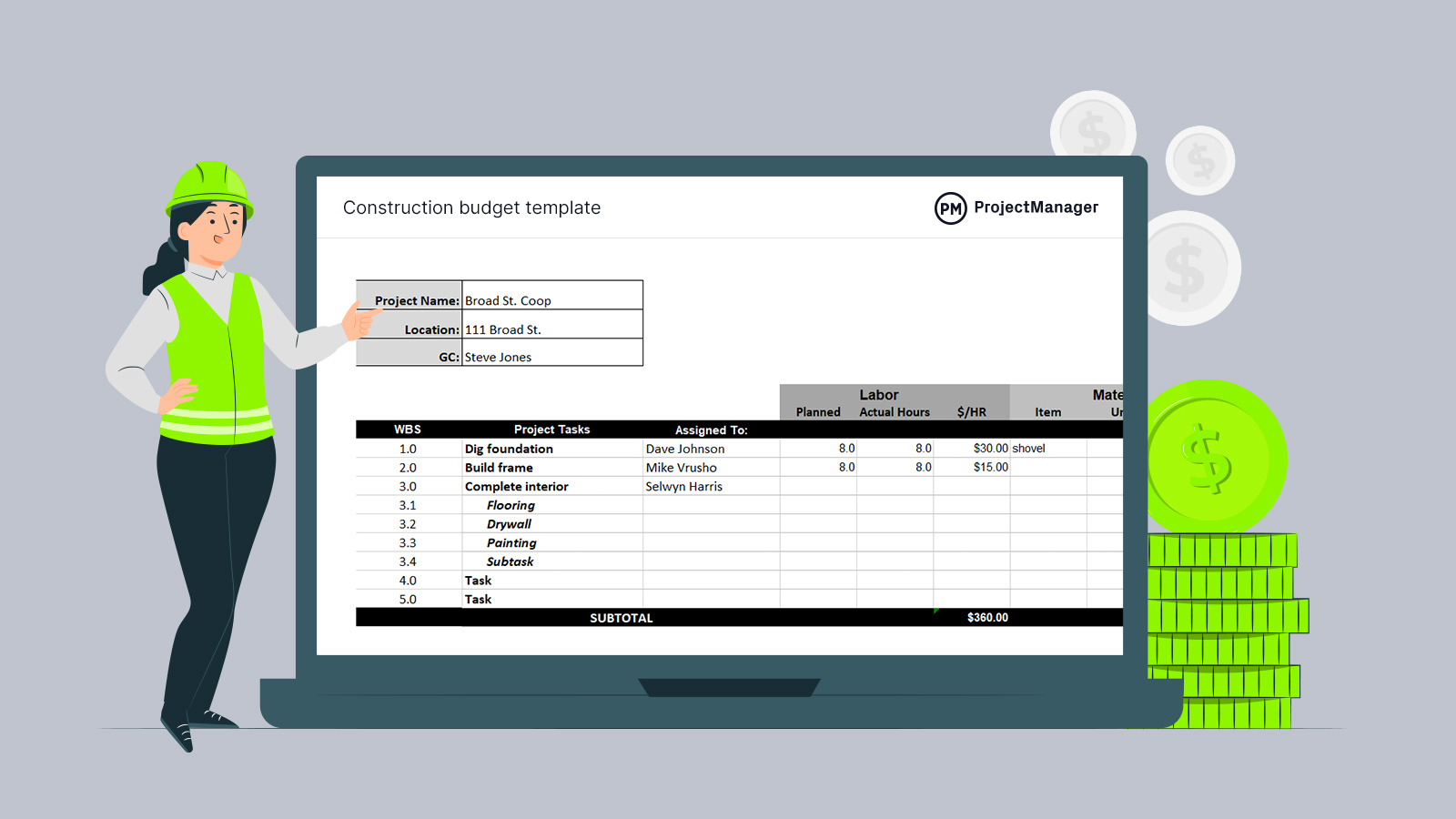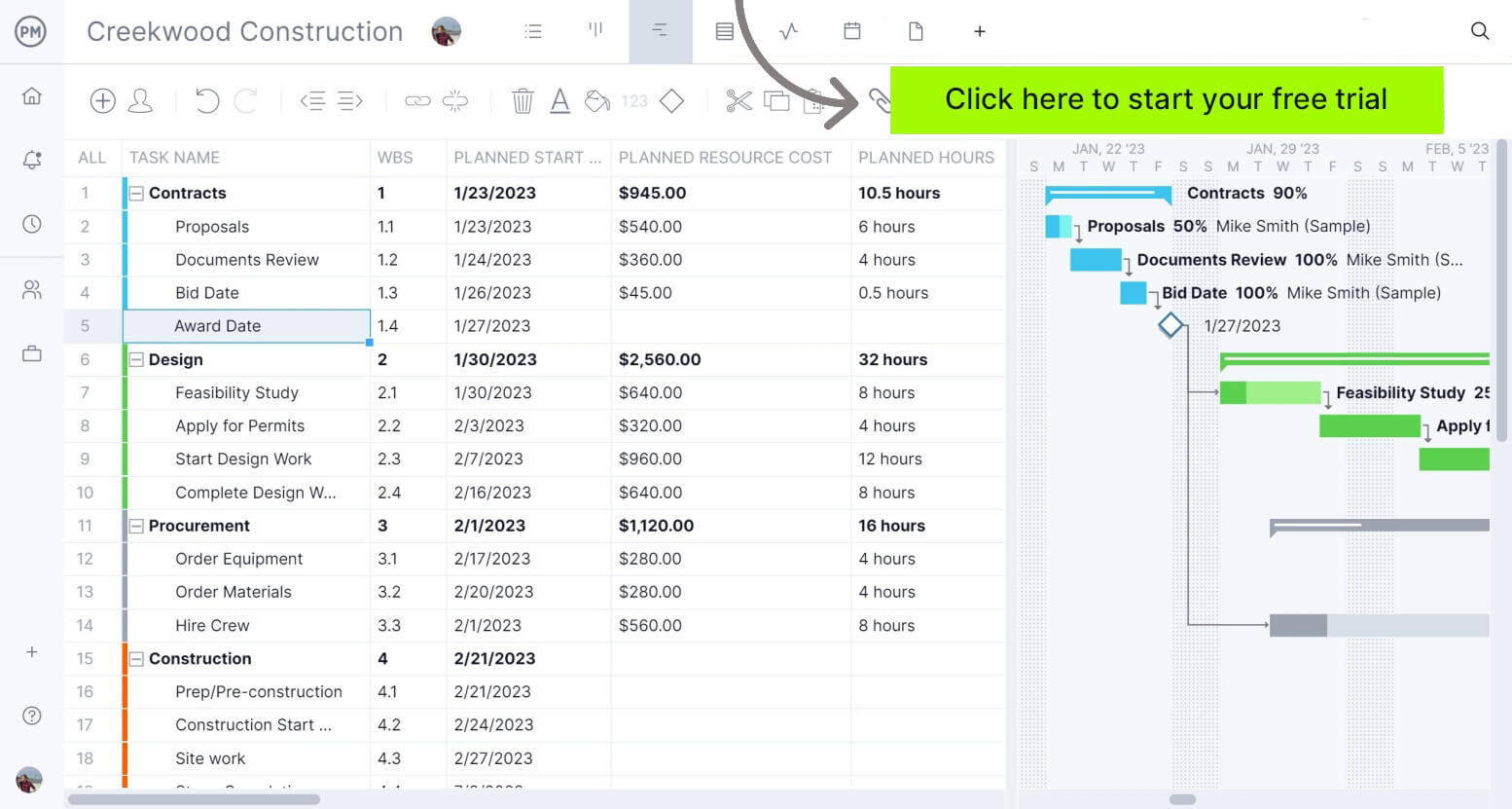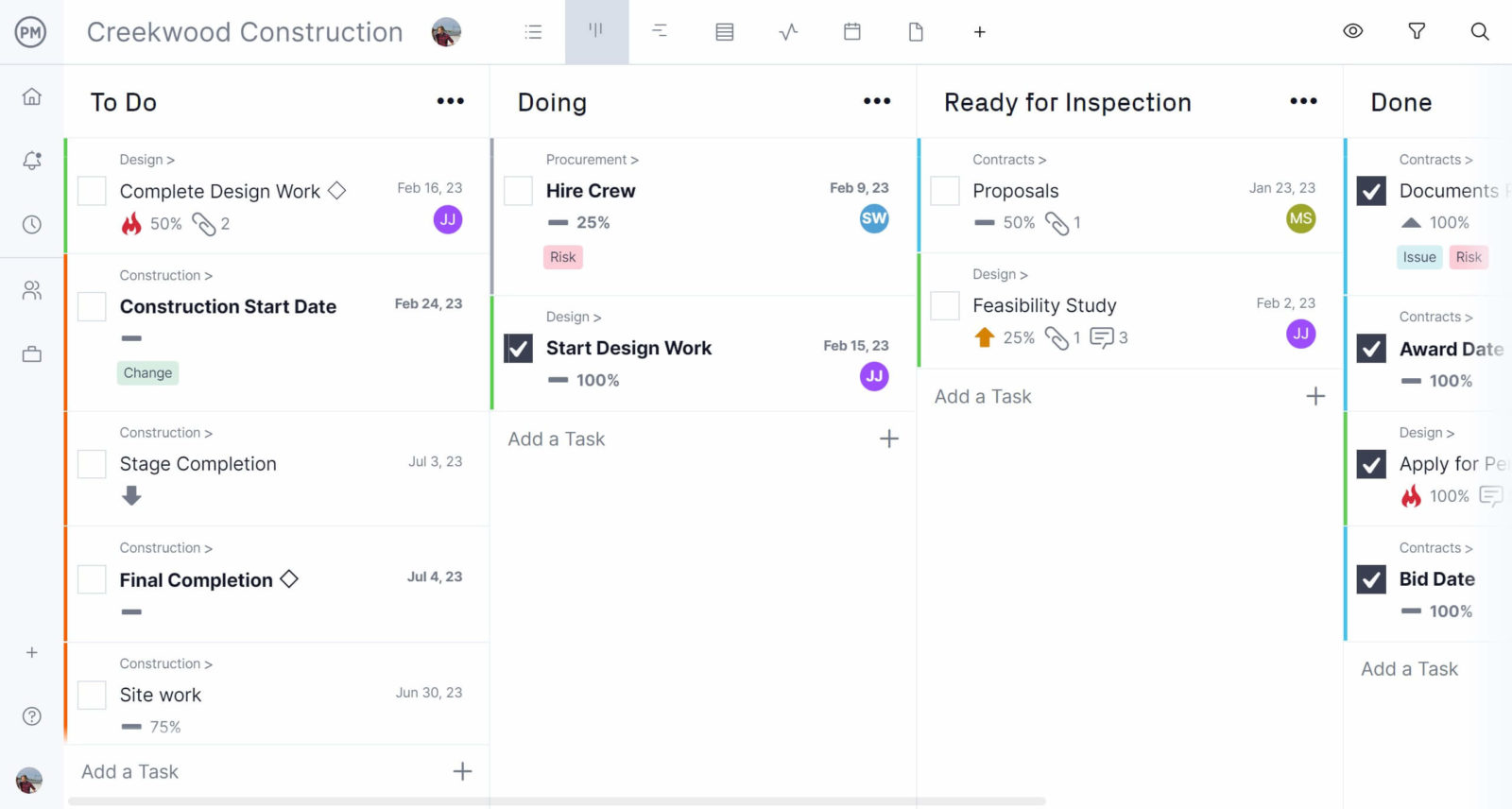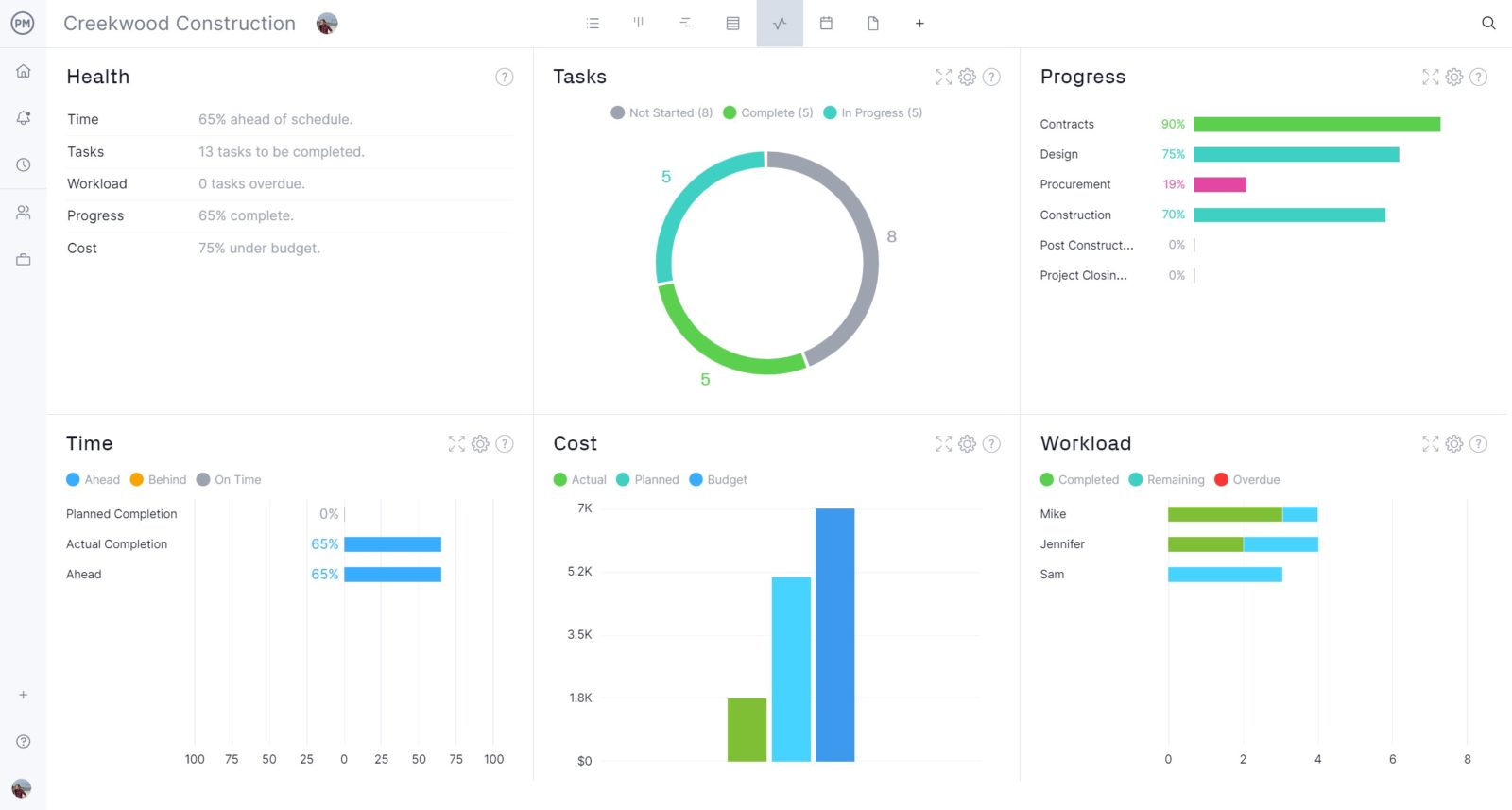Construction procurement can maximize a construction project’s efficiency. While construction project management includes all project plans and schedules, without the goods and services provided by procurement in construction, it’s an idea, not a structure.
The importance of proper construction procurement cannot be overstated; the process of getting those goods and services to the construction site efficiently can make or break the project. Let’s look at procurement in construction, the methods used and the role of the construction procurement manager.

Get your free
Construction Budget Template
Use this free Construction Budget Template for Excel to manage your projects better.
What Is Procurement in Construction Management?
Construction procurement is the acquisition of materials, equipment, services or any other resources needed for a construction project. It’s an essential process with lots of moving parts such as building relationships with outside vendors and suppliers, controlling costs, managing documentation and contracts and more. Here are some of the things you’ll need to know when procuring resources for your construction project.
- Material Procurement: You’ll need to identify the different types of raw materials needed for your project, such as lumber, cement, steel or glass by making a material takeoff. This is an important construction document that itemizes these materials and indicates information such as the exact quantities for each and their cost.
- Services Procurement: In construction, services procurement refers to the hiring of contractors and subcontractors for the execution of a project, or a portion of it. If you need to subcontract some construction work, you can use a request for proposal (RFP), get bids and select the best deal for your project.
- Equipment Procurement: The construction industry involves the use of many types of equipment, from basic tools to heavy-duty machinery. You should thoroughly review the scope of work of your project to determine what type of construction equipment needs to be purchased or rented during the preconstruction phase.
To manage your construction procurement process effectively, you’ll need construction project management software to oversee your resources, budget and timeline. ProjectManager allows you to define variables on robust Gantt charts before you make this important decision. Estimate the costs of your resources and budget while organizing tasks on a timeline. Our software even filters for the critical path and sets a baseline to track project variance once construction starts. Get started with ProjectManager today for free.

The 5 Construction Procurement Methods
A construction company must look strategically at its construction procurement so it’s as efficient as possible. The company wants to purchase supplies in the most cost-effective way which means considering the project timeline, quality expectations, and, of course, the budget.
Various methods accomplish this and each has advantages and disadvantages. A construction company must know all five types of procurement methods (general contracting, design and build, construction management, joint venture and private financing) to know which is right for them and their project.
General Contracting
General contracting is the most popular and widely used method of construction procurement. It involves a company or individual delivering a design for the contractor to build. This procurement method is great when the design has been completed before the project begins. There’s then a clear division of duties and budget.
However, because general contracting is a split division of responsibilities and accountability, there can be disagreements about who’s responsible for problems that might arise throughout the project’s lifecycle. That’s why general contractors who use this construction procurement method often invest in preventive maintenance to get a higher quality of work at lower costs.
Design and Build
With design and build, the weight of the project is on the contractor’s shoulders. They take on all responsibilities, risks and the management of both the design and the build of the construction project throughout all its phases.
For this to work, the contractor usually has a larger internal staff with skilled facility management staff to manage every aspect of the design and build. Another way to proceed with this type of construction procurement method is for contractors to partner with other contractors to complete the job. Either way, the benefits and deficits are both large.
Construction Management
This construction procurement method is best for developers who specialize in larger, more complex projects that usually have internal management resources. This is a preferred procurement method for construction as developers will subcontract every aspect of the project to the best qualified and lowest bidder.
It’s time-consuming to use this construction procurement method and the process is complicated. Yet, companies can find it a cost-saving method if they make each component of the process as competitive as possible. You’ll need to have a sophisticated supply change management process, too, to reap those benefits.
Joint Venture
Similar to construction management, the joint venture construction procurement method also plays off the strength of different parties, but the two methods aren’t identical. For example, a joint venture doesn’t put the main control and accountability in the hands of the client. Instead, the control and accountability are for the joint venture management team.
This type of procurement for construction method helps prevent the participating parties from blaming one another. Instead, they’re focused on accomplishing the client’s objectives. This creates a more cohesive team and therefore a more productive and efficiently executed project.
Private Financing
Private financing is much less common than any of the four other construction procurement methods, but it’s still an alternative for clients with poor financial backgrounds. The contractor is responsible for all construction risks until the project is completed. Only once the construction project is complete is it transferred to the client.
Construction Budget Template
Before you can make any procurement decisions, you’ll need to create a construction budget, which will give you an idea of how much your project will cost. It’ll also help you set a spending limit for the purchase of raw materials, equipment, machinery and labor. This free construction budget template for Excel is ideal for listing down all your project resources and their costs.

Construction Procurement Process
Now let’s go over some key steps that you’ll need to take when managing the construction procurement process.
1. Define the Scope of Work
The scope of work is a document that defines all the tasks that will be executed to successfully deliver a construction project. This is a very important document because it’s used to establish an agreement between a project owner and the contractor who will be executing the work.
2. Create a Material Takeoff and Quantity Takeoff (QTO)
Once you define the activities that will make up your construction project such as pouring the foundation, building the frames, insulation and roofing, you’ll need to estimate the needed resources for each of these stages.
This requires a quantity takeoff (QTO), which is a more thorough version of the material takeoff (MTO) as this document also includes labor.
3. Create a Project Budget
After defining the scope of work of your project and creating a quantity takeoff (QTO) you’re ready to estimate the costs of the materials, labor, equipment and any other needed resources for executing your project work.
Once you’ve accurately estimated these costs, you can create a project budget, which will help you keep track of costs and set limits for spending.
4. Choose a Procurement Method
You should choose the construction procurement method that works best for you whether you’re a project owner or contractor in terms of the degree of control, risk and responsibility you have over the construction procurement process.
5. Write Your Construction Procurement Plan
A construction procurement strategy is a construction document that describes your construction procurement strategy, or the set of guidelines, tools and procedures that’ll be used to manage your construction procurement process.
For example, a construction procurement plan should explain the criteria for the selection of bidders and the evaluation of bids, payment terms and quality standards for materials, among many other important details.
6. Send Request for Proposals (RFPs) or Request for Quotes (RFQs)
Request for proposals (RFP) and request for quotes (RFQs) are two documents to help you get bids for the procurement of materials and labor.
An RFP allows you to get bids from contractors or subcontractors for the execution of work, while you can use an RFQ to get a quote for purchasing goods from a supplier.
7. Evaluate Bids and Award Contracts
Once you’ve gathered proposals from various contractors, subcontractors and suppliers, you and your project stakeholders need to decide which bids are the best fit for your project, which usually are those with the best price/quality ratio, even though there might be other additional variables to consider, such as quality of materials, expertise or project delivery time.
8. Monitor Contract Compliance
Signing a construction contract is only the beginning. While construction contracts specify the responsibilities, terms and conditions, unfortunately not all contractors, subcontractors or suppliers will play their part as expected.
You’ll need to monitor your construction site periodically to ensure that your contractors are executing the work that was agreed upon on time, on budget and meeting the quality standards.

More Free Construction Procurement Templates
We’ve created dozens of construction project management templates for Word and Excel, which can help you manage all the areas of your construction project, including procurement.
Scope of Work Template
This template helps you describe the scope of work of a construction project, including the key deliverables, milestones, resource requirements and exclusions.
Request for Quote Template
This free request for quote template allows you to get a quote from a supplier for the purchase of materials and specify their quantity, unit price, shipping terms and more.
Resource Plan Template
This free resource plan template for Excel is ideal for listing all the resources that will be needed to execute your project, their costs and the exact dates when they’re needed.
The Role of the Construction Procurement Manager
Depending on the construction project and the company executing the build, the responsibilities of construction procurement can rest on any number of project team members. For a smaller project, the job might fall to the construction project manager. But there’s also a dedicated position of construction procurement manager.
The title of construction procurement manager is sometimes known as the purchasing manager, but either way, the person filling that position must be a supply chain and logistics professional. The construction procurement manager is responsible for the purchase of all materials and finding the most cost-effective and appropriate ones for the job.
The construction procurement manager is also responsible for making sure the materials purchased arrive on time and are within the agreed-upon budget. This involves a lot of work as material prices are constantly changing and often fluctuate significantly without warning. This requires the procurement manager to be analytical, negotiate and have strong communication and business skills. They must also have the ability to budget with knowledge of the construction industry.
Beyond that, other responsibilities go beyond managing the supply chain strategy. For example, some regulations must be met, maintaining stock to keep the construction crew able to work at capacity and more. Here are some of the other duties and responsibilities of a construction procurement manager.
Creating a Procurement Management Plan
The procurement management plan is under the purview of the construction procurement manager and it involves several steps. You need to first define the terms, knowing what you need in detail. Then, outline the type of agreement you’re going to use, such as a fixed price or cost-reimbursement contract.
Risk management is also part of the plan, which means identifying and mitigating risks. The costs must be thoroughly defined and any constraints identified. Once this is done and the contract details are approved, create decision criteria and create a vendor management plan.
Evaluating Bids and Requests for Proposals (RFP)
The construction procurement manager also deals with the bidding process. Once the procurement management plan has detailed what materials are needed, you need to get them. That’s when vendors will bid on the job. The construction procurement manager will send out RFPs and then analyze those that come back to figure out which ones are the best fit for the project.
They must then manage these vendors throughout the lifecycle of the construction project to ensure they’re delivering what was asked for, at the price and schedule agreed on. After the vendor is done, the contracts must be properly closed.
Overseeing Resource Management
Another issue is resource management. The construction procurement manager identifies all the material side of the resources necessary to execute the job and makes sure they’re available when needed by the construction crew. The construction procurement manager must understand the times for all the material needed and how long it takes for the process to go from shop drawings to approvals to have the material on hand when it’s needed. Avoid idle time as it delays the schedule and adds costs to the project.
Tracking Projects
The procurement manager must also maintain the construction procurement schedule. They need to coordinate the procurement schedule with both the project manager and the project construction schedule. The procurement manager will ensure that materials arrive when they’re needed, helping to monitor the progress of delivery and track the materials to make sure they’re meeting the milestones in the procurement schedule.
ProjectManager Helps With Construction Procurement
There are many responsibilities on the construction procurement manager’s shoulders. This is where construction project management software comes in. ProjectManager is software that helps construction procurement managers plan, monitor and report on their work. We have the features they need to schedule tasks, track progress in real time and keep stakeholders updated so everyone is always on the same page.
Manage Procurement on Kanban Boards
While the Gantt chart is great for planning your schedule and managing resources, the construction procurement manager often wants to focus on the process. That’s why we have multiple project views, such as kanban boards where you can track materials as cards under columns to note where everything is in the supply chain. Construction procurement managers can quickly see if there are bottlenecks and resolve them before they cause delays or extra costs.

Track Projects in Real Time With Live Dashboards
Another way to monitor the progress of your supply chain is with our real-time dashboards. They automatically capture and calculate six project metrics which are displayed in easy-to-read graphs and charts. There’s no setup required as with lightweight tools. Ours is plug-and-play and it’s like getting an instant status report. You can also generate customizable reports with one click to go deeper into that data and keep stakeholders updated.

Because our software is online, it fosters collaboration and allows you to stay in real-time contact with your vendors and the construction project team on site. You can comment, tag others to bring them into the conversation and share files. It doesn’t matter if you’re in the office, on the job site or traveling, you’re always connected with the project.
ProjectManager is award-winning software that helps procurement managers do their job more effectively. Create your construction procurement plan, manage resources and track the progress of materials to ensure they arrive on time and within your budget. Get started with ProjectManager today for free.

